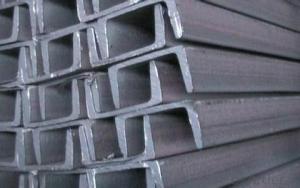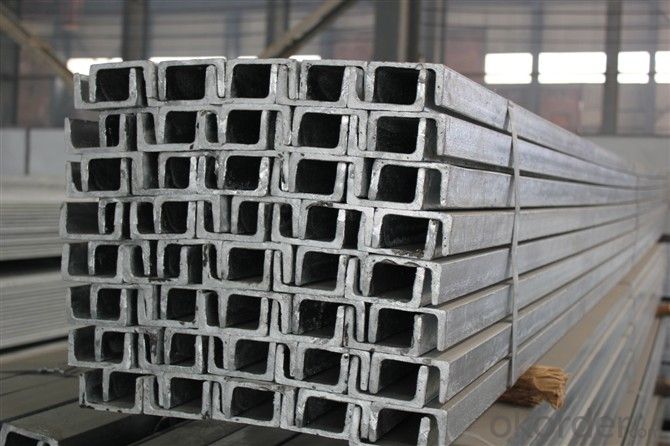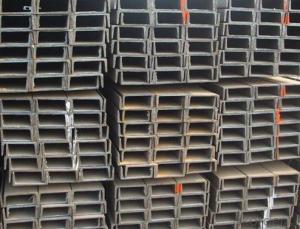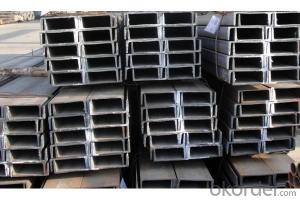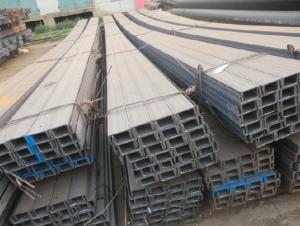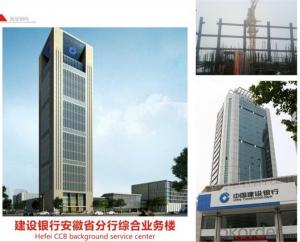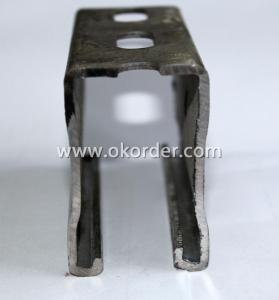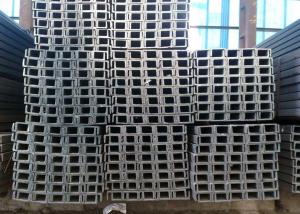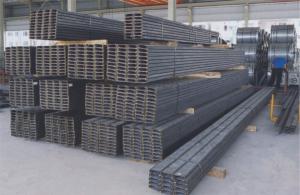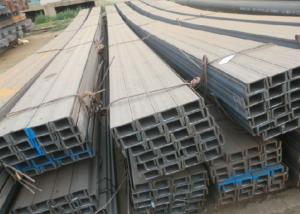steel channel for construction
- Loading Port:
- Tianjin
- Payment Terms:
- TT OR LC
- Min Order Qty:
- 1000 m.t.
- Supply Capability:
- 10000 m.t./month
OKorder Service Pledge
OKorder Financial Service
You Might Also Like
Product Description:
Steel U Channel Details:
Minimum Order Quantity: 25 Tons Unit: m.t. Loading Port: Xingang Port
Supply Ability: 1000 Tons Per Day Payment Terms: TT or L/C
Product Description:
Specifications of Steel U Channel:
Standard Applied: GB Standard, EN Standard(UPN), JIS Standard
Sizes: 50mm to 300mm
Material Grade: Q235B, Q345B, S235JR, SS400, ASTM A36
As shown in the figure:
Usage/Application of Steel U Channel:
The steel u channel can be applied to construction of warehouses, workshops, sport stadiums and car parks etc. In details, the steel u channel belongs to carbon structural steel which is applied to in the field of construction and machinery. The steel u channel is usually used for arch-itechtural structure, and they could be welded in order to support or hang a vari-ety of facilities. They are also usually used in combination with I beam. Generally,the steel u channel must possess perfect welding property, riveting property and mechanical property and so on.
Package & Delivery: Steel U Channel
The steel u channel will be packed in bundle with steel wire at each end of every bundle and color marking in order to help the customer to recognize his goods more easily at sight.
And steel u channel could be loaded into 20ft or 40ft container, or by bulk cargo. If the weight of each bundle reaches less than 3.5 mt, the loading by break bulk cargo should be choosed. When the weight of each bundle reaches less than 3mt, the loading by container should be choosed.
As for the transportaion from mill to loading port, the truck will be usually used. And the maximum quantity for each truck is 40mt.
All in all, we could do in accordance with customer's request
- Q: What type of channel is used for the type of room with a span of 4 meters?
- By experience, use 14# i-beam.
- Q: What are the different applications of steel channels in the automotive industry?
- Steel channels are widely used in the automotive industry for various applications. They are commonly utilized in the construction of vehicle frames, where they provide structural support and help enhance the rigidity and strength of the frame. Steel channels also find use in the manufacturing of suspension systems, providing stability and durability. Additionally, they are used in the production of vehicle doors and body panels, offering reinforcement and protection. Overall, steel channels play a vital role in ensuring the safety and performance of automobiles.
- Q: Are steel channels suitable for earthquake-prone regions?
- Yes, steel channels are suitable for earthquake-prone regions. Steel is a strong and flexible material that can withstand seismic forces and provide structural stability during earthquakes. The use of steel channels in construction allows for better resistance to lateral loads and enhances the overall resilience of buildings in earthquake-prone areas.
- Q: Can steel channels be used for framing door and window openings?
- Yes, steel channels can be used for framing door and window openings. Steel channels are commonly used in construction for structural support and framing purposes. They are known for their strength and durability, making them suitable for framing openings. Steel channels provide a sturdy framework that can support the weight of the doors and windows without flexing or warping. Additionally, steel channels offer excellent resistance to corrosion and can withstand extreme weather conditions, making them a reliable choice for framing door and window openings in both residential and commercial buildings.
- Q: How do steel channels compare to other building materials?
- Steel channels have several advantages over other building materials. Firstly, steel channels have a high strength-to-weight ratio, making them an ideal choice for structural support applications. They can withstand heavy loads and provide excellent stability and durability. Additionally, steel channels are highly resistant to fire, corrosion, and pests, which makes them a reliable and long-lasting option for construction projects. They do not rot, warp, or require frequent maintenance, making them a cost-effective choice in the long run. Moreover, steel channels offer versatility in design and construction. They can be easily customized and fabricated to meet specific project requirements. Steel channels also provide flexibility during the construction process, as they can be easily modified or reinforced if needed. Furthermore, steel channels are environmentally friendly. They can be recycled and reused without losing their properties, making them a sustainable choice for construction projects. Steel production also requires less energy compared to other building materials, reducing the carbon footprint. Lastly, steel channels offer cost-effectiveness. While the initial cost may be higher than some other materials, the long-term benefits outweigh the investment. They require minimal maintenance and have a longer lifespan, resulting in lower maintenance and replacement costs over time. Overall, steel channels are a superior choice compared to other building materials due to their strength, durability, resistance to fire and corrosion, versatility, sustainability, and cost-effectiveness.
- Q: What are the environmental benefits of using steel channels?
- There are several environmental benefits associated with using steel channels: 1. Recyclability: Steel is one of the most recyclable materials on the planet. It can be recycled indefinitely without losing its properties or quality. By using steel channels, we contribute to reducing the demand for raw materials and the energy required for their extraction and production. 2. Energy efficiency: Steel channels are often used in construction and infrastructure projects. Steel is known for its high strength-to-weight ratio, which means that less material is needed to achieve the desired structural integrity. This not only reduces the overall weight of the structure but also lowers the energy required for transportation and installation. 3. Durability and longevity: Steel is highly durable and can withstand extreme weather conditions, corrosion, and pests. Steel channels are designed to have a long lifespan, reducing the need for frequent replacements or repairs. By using steel channels, we can minimize waste and the environmental impact associated with the disposal of deteriorated materials. 4. Reduced carbon footprint: The production of steel channels emits lower greenhouse gas emissions compared to other building materials, such as concrete or aluminum. Additionally, advancements in steel manufacturing techniques have led to the development of more sustainable and energy-efficient processes, further reducing the carbon footprint of steel production. 5. Fire resistance: Steel is a non-combustible material, making it a safer choice for construction in terms of fire resistance. By using steel channels, we can enhance the overall fire safety of structures and reduce the potential environmental impact of fire incidents. Overall, using steel channels can contribute to environmental sustainability by promoting recycling, conserving energy, minimizing waste, reducing carbon emissions, and enhancing fire safety.
- Q: 24 meters long, 4 meters per column, 6 meters wide. How large channel steel should be used to make the beam?
- The channel should not be used as bearing beam, 6 meters 4 meters across the Bay 14~16 I-steel beam available 1.2~1.5 m spacing C or Z shape.
- Q: Can steel channels be used for railway tracks?
- No, steel channels cannot be used for railway tracks. Railway tracks require a specific type of steel called "rail steel" or "railroad steel" that is specifically designed and manufactured for the purpose of constructing railway tracks. Rail steel has certain properties that make it suitable for withstanding the heavy loads, constant stress, and wear and tear that railway tracks face. It has a specific chemical composition and is made through a specialized manufacturing process to ensure its durability and strength. Steel channels, on the other hand, are not designed to withstand the same level of stress and wear as rail steel and would quickly deteriorate under the heavy loads and constant movement of trains. Therefore, it is essential to use rail steel for constructing railway tracks to ensure the safety and efficiency of the rail system.
- Q: How do steel channels contribute to building aesthetics?
- Building aesthetics can be enhanced in several ways by incorporating steel channels. Firstly, these channels serve as structural elements, providing strength and stability to the overall structure. However, they also play a significant role in improving the visual appeal of a building. One of the primary ways steel channels contribute to building aesthetics is through their sleek and contemporary appearance. With their clean lines and smooth surface, steel channels can give a building a modern and sophisticated look. They can be utilized in a range of architectural designs, from industrial to minimalist, adding a touch of elegance and refinement to the overall aesthetic. Furthermore, steel channels offer great versatility in terms of design possibilities. Architects and designers can easily customize and fabricate them into various shapes and sizes, allowing for the creation of unique and visually striking elements. Steel channels can be employed as decorative features like handrails, balustrades, or window frames, thereby adding visual interest and architectural detailing to the building. Moreover, steel channels can be finished with different coatings or treatments to further enhance their aesthetic appeal. They can be painted in various colors to complement the overall design scheme or left exposed, showcasing the natural beauty of steel. Additionally, they can be polished or brushed to achieve different textures and finishes, thereby adding depth and character to the building's appearance. Furthermore, steel channels can contribute to the aesthetics of a building by creating a sense of openness and transparency. When used as structural elements in facades, they can support large glass panels, allowing for expansive views and the entry of natural light into the building. This creates a visually pleasing and inviting atmosphere, connecting the interior spaces with the surrounding environment. In conclusion, steel channels enhance building aesthetics by providing a sleek and contemporary appearance, offering design versatility, enabling customization, and creating a sense of openness. With their clean lines, smooth surface, and various finishing options, steel channels can elevate the visual appeal of a building, adding elegance, sophistication, and architectural detailing to the overall design.
Send your message to us
steel channel for construction
- Loading Port:
- Tianjin
- Payment Terms:
- TT OR LC
- Min Order Qty:
- 1000 m.t.
- Supply Capability:
- 10000 m.t./month
OKorder Service Pledge
OKorder Financial Service
Similar products
Hot products
Hot Searches
Related keywords
